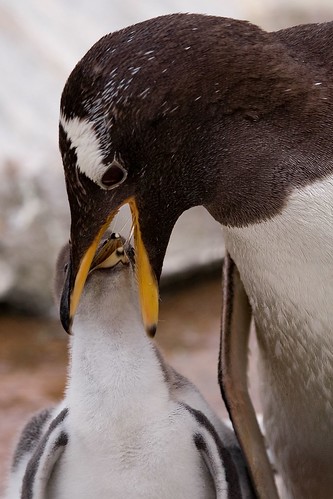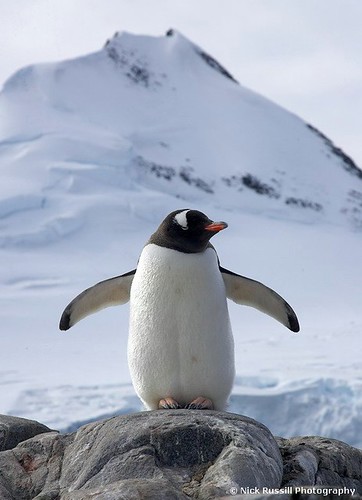




Facts
Kingdom Animalia
Phylum Chordata
Class Aves
Order Sphenisciformes
Family Spheniscidae
Genus Pygoscelis (1)
Size Height: 73 – 81 cm (2)
Male weight: 4.9 – 8.5 kg (3)
Female weight: 4.5 – 8.2 kg (3)
Status
Classified as Near Threatened (NT) on the IUCN Red List 2007 (1).
Description
This charismatic marine bird is easily distinguished from other penguins by its bright orange-red bill and the conspicuous white patches above each eye (3). These white patches, which usually meet across the crown, contrast highly with the black head and throat, but there may also be a scattering of white feathers on the head. The white underparts are sharply separated from the penguin's bluish-black back, which appears browner as the feathers become worn (3). The gentoo penguin has pale whitish-pink webbed feet and a fairly long tail - the most prominent tail of all penguins (2) (3) (4). As the gentoo penguin waddles along on land, its tail sticks out behind, sweeping from side to side, hence the scientific name Pygoscelis, which means ‘brush-tailed' (4). The gentoo penguin calls in a variety of ways, but the most frequently heard is a loud trumpeting which is emitted with its head thrown back (5).
Range
The gentoo penguin has a circumpolar distribution, breeding on sub-Antarctic Islands and the Antarctic peninsula (3). Two subspecies of the gentoo penguin are recognised (2): Pygoscelis papua papua breeds mainly on the Falkland Islands and South Georgia, Kerugulen, Heard, Macquarie and Staten Islands, while Pygoscelis papua ellsworthi breeds on the Antarctic Peninsula, South Shetland Island, South Orkney and South Sandwich Island (3). The gentoo's non-breeding range is not fully known, but they have been found as far north as New Zealand, Australia and Argentina (3).
Habitat
This marine bird can be found searching for food in inshore waters (2). When breeding, the gentoo penguin favours flat ground (2), either close to the coast or a considerable distance inland (3), where it nests in rocky areas, sometimes amongst vegetation (2).
Biology
A gregarious bird, but less so than some other penguin species (2), the gentoo can form breeding colonies ranging from thirty to thousands of pairs (5). Arriving at suitable nesting ground between June and November (the exact date depending on the location) (2), each pair of penguins will set about the task of constructing a nest from stones, tussock grass and moss (2). The penguins tear up plants to use as nest material and fertilise the ground with their droppings, resulting in grass growing well the subsequent year, hence their favourable reputation with sheep farmers (5).
Into these nests two white, spherical eggs are laid, which are incubated by both the male and female for 31 to 39 days (2). The penguin chicks fledge after 85 to 117 days, but continue to be fed by their parents for a further 5 to 50 days. Gentoo penguins, which reach sexual maturity at the age of two years (2), are not only faithful to certain nest sites, with most returning to the previous year's nest, but they are also loyal to breeding partners, with many forming long-lasting pair bonds (3).
Walking with a rather comedic, waddling gait on land, the gentoo penguin shows its true talents when in the water. With its stream-lined body and ‘flippers' that provide effective propulsion through the water (6), the gentoo penguin dives deep into the ocean in pursuit of its prey, and is capable of reaching impressive depths of up to 170 metres (3). The exact diet of the gentoo penguin varies depending on location, but can include Atlantic krill, other crustaceans, fish, cephalopods and polychaetes (2).
Threats
Although not globally threatened with extinction, some gentoo penguin colonies have declined (1). While those on the Antarctic Peninsula appear to be increasing overall, populations on sub-Antarctic islands may have decreased considerably (1). For example, populations on Bird Island (South Georgia) have decreased by around 67 percent since 1980 (1). In the past, some colonies were affected by the collection of eggs for human consumption and the hunting of adults for their oil (2). Today, possible reasons behind population declines include local pollution, interaction with fisheries, and disturbance by humans (1); colonies on Kerguelen Island and Possession Island are said to have been disturbed by the presence of scientific bases (2).
Conservation
The gentoo penguin breeds in a number of protected areas, including MacQuarie Island and Heard Island, which are both Natural World Heritage Sites (7), and Prince Edward Islands Special Nature Reserve (8). To prevent the charming gentoo becoming threatened with extinction, the global bird conservation organization BirdLife International have recommended that efforts need to be made to avoid any disturbance of breeding colonies, and that colonies should be subject to long-term monitoring (8).
Further Information
For further information on the conservation of penguins see:
* International Penguin Conservation Work Group:
www.penguins.cl
References
1. IUCN Red List (June, 2008)
http://www.iucnredlist.org
2. del Hoyo, J., Elliott, A. and Sargatal, J. (1992) Handbook of the Birds of the World. Volume 1: Ostrich to Ducks. Lynx Edicions, Barcelona.
3. Williams, T.D. (1995) Bird Families of the World: The Penguins. Oxford University Press, Oxford.
4. British Antarctic Survey (June, 2008)
http://www.antarctica.ac.uk/about_antarctica/wildlife/birds/penguins/gentoo.php
5. Woods, R.W. (1975) The Birds of the Falkland Islands. Anthony Nelson, Shropshire, UK.
6. Burnie, D. (2001) Animal. Dorling Kindersley, London.
7. World Database on Protected Areas (July, 2008)
http://www.unep-wcmc.org/wdpa
8. BirdLife International (July, 2008)
http://www.birdlife.org/datazone/species/index.html?action=SitHTMDetails.asp&sid=7176&m=0
Info courtesy of ARKive@
http://www.arkive.org/gentoo-penguin/pygoscelis-papua/info.html
Pix from Flickr

















No comments:
Post a Comment